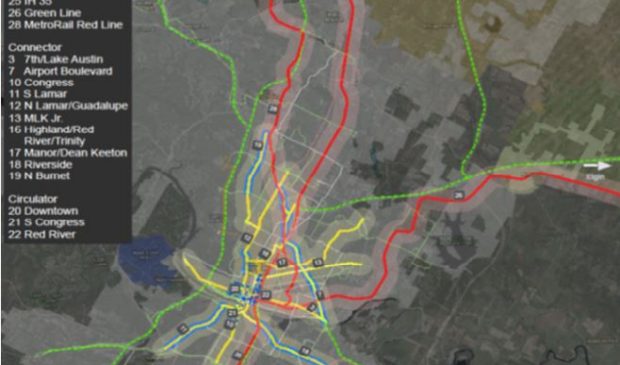Transit priority is a top priority for Project Connect
Friday, November 17, 2017 by
Caleb Pritchard Project Connect is doomed unless the city hands over dedicated right of way.
That was the message relayed by Javier Arguello, long range planning director for the Capital Metropolitan Transportation Authority, to the city’s Urban Transportation Commission on Tuesday night.
Arguello told the body that the high-capacity transit investments Project Connect is ultimately trying to create must be able to operate on dedicated rail or lanes in order to provide faster, more reliable service.
“Without these two components, we probably need to stop right now and do something else,” he said.
Past planning processes began with the assumption that dedicated right of way would be provided, Arguello continued. This time, however, his team is seeking commitments up front from the city.
That request could face political headwinds. During the previous iteration of Project Connect that produced the failed 2014 urban rail proposal between Highland Mall and East Riverside Drive, advocates argued that the investment should be made on the Guadalupe-Lamar corridor.
Then-Mayor Lee Leffingwell dismissed the idea based on his concerns that it would reduce car lanes on a heavily traveled artery. “Nobody, least of all me, is going to be willing to turn Lamar Boulevard into a two-lane route for rail,” he said, according to the Austin American-Statesman.
“That was 2014,” Arguello told the Austin Monitor on Tuesday. “We’re in 2017, moving into 2018. The need is increasing dramatically.”
When asked by Commissioner J.D. Gins whether Project Connect planners and city staff see eye to eye on the need for dedicated right of way, Arguello said yes.
“Absolutely,” he affirmed. “We are coordinating the efforts to help us achieve those decisions,” he said.
That coordination is occurring within the partnership of Project Connect and the city’s development of the Strategic Mobility Plan. Earlier this year, the Transportation Department folded its City Council-directed development of a transit-priority policy into the SMP initiative.
Although the two major planning efforts have similar timelines, Project Connect is scheduled to deliver its proposed high-capacity network before the SMP team debuts its preferred transportation scenario, or the collection of projects and policies that will guide the long-term future of mobility in the city.
By design, Project Connect’s selection of specific modes on specific corridors must precede the development of the policy, according to Transportation Department Assistant Director Annick Beaudet.
“The transit priority policy will come once we know where the transit needs to go,” she told the Austin Monitor.
One wrinkle in the plan, however, is the ongoing development of the corridor implementation plan, which is expected to be delivered to Council as early as February. That document will spell out how $486 million in voter-approved bond money will get spent on select corridors within the eight-year time frame that began ticking down after the November 2016 election.
During last week’s meeting of Council’s Mobility Committee, Council Member Ann Kitchen asked staff how the decisions to incorporate transit-priority projects were being made.
“We are concerned about it, and you’re asking the right questions,” responded Assistant City Manager Robert Goode. “Who’s going to decide that, by when, and can we then design that into our corridors? Or, are we going to have to put those corridors on the back burners and go do something else that we more clearly know is going to be built, and it’s not going to be affected by a transit decision? And that’s what we’re spinning on now.”
Goode raised the possibility of a delay in the corridor program given that dilemma of deciding where to allow dedicated right of way. Council Member Greg Casar, who sat in briefly on that meeting, worried that any delay could further complicate things.
“That’s part of the challenge of living in such a rapidly changing environment. At some point, we do have to just decide,” he said.
On Tuesday night, Arguello said the drive for dedicated right of way will require support from all levels, from regional entities down to grassroots activists.
“The leadership is about the attitude of the people who have the opportunity to leverage decisions in the right direction,” he said. “It’s not on a specific individual. It’s a collective effort.”
The Austin Monitor’s work is made possible by donations from the community. Though our reporting covers donors from time to time, we are careful to keep business and editorial efforts separate while maintaining transparency. A complete list of donors is available here, and our code of ethics is explained here.
You're a community leader
And we’re honored you look to us for serious, in-depth news. You know a strong community needs local and dedicated watchdog reporting. We’re here for you and that won’t change. Now will you take the powerful next step and support our nonprofit news organization?



